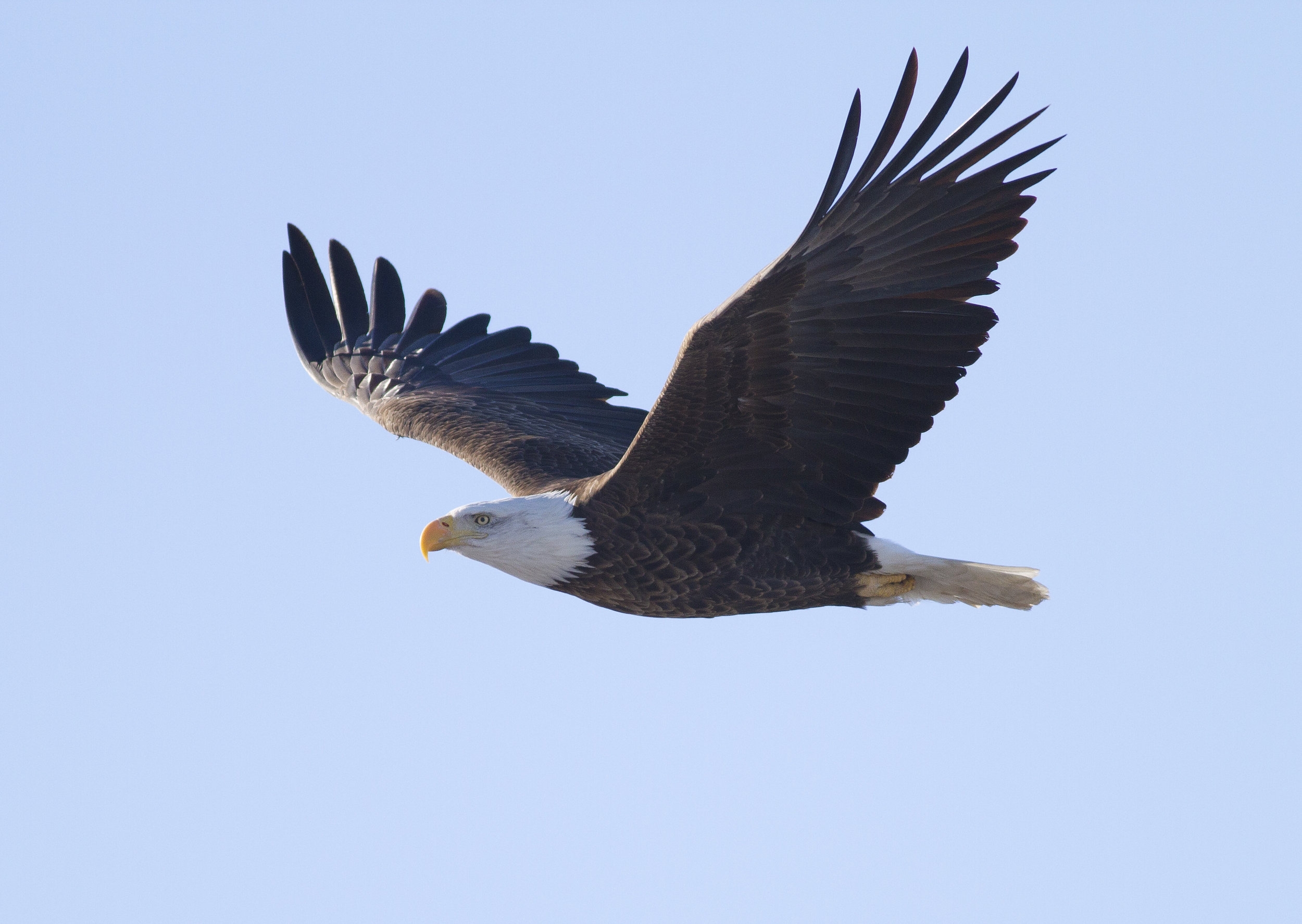Eagles soar anew
DDT ban led to bald eagles' revival, but now what about the dangers of lead shot?
Illinois claims to have more wintering bald eagles annually than any state other than Alaska. (Wikimedia Commons/Steve Berardi)
By Ted Cox
Please allow One Illinois to propose a new state motto, in case that “Land of Lincoln” thing ever stops working for you.
How about: “Illinois, where bald eagles are like sparrows.”
A guard at the Mississippi River Visitor Center on the Rock Island Arsenal said in March that visitors had suggested eagles had become so numerous upriver they were “like sparrows.” And that was as she very matter-of-factly trained a telescope on a magnificent bald eagle perched on a log in the basin above the lock and dam there for visitors to see.
Bald eagles: they were almost a national disgrace, but now they’re an American success story.
According to Rachael Heaton, rehabilitation manager at the TreeHouse Wildlife Center in Dow, just inland between the Mississippi River towns of Alton and Grafton, about 500,000 bald eagles once roamed the United States. Yet hunting, reduction of their habitat, and pollution reduced the population to about 500 nesting pairs as recently as 55 years ago.
The national bird was in danger of extinction. According to Rachel Carson’s landmark 1963 book “Silent Spring,” one of the main culprits was the pesticide DDT, which washed into the water and got into the eagles’ system through the fish they ate, with the consequence that the substance thinned their egg shells to the point where they couldn’t sustain life.
In 1972, the Environment Protection Agency took what even the U.S. Fish & Wildlife Service now calls “the historic and, at the time, controversial step of banning the use of DDT.”
And the results have been remarkable by almost any standard.
Eagles have sprung back across the nation, and about 25 years ago they started turning up in Alton, near the then-new Melvin Price Locks & Dam, which was soon followed by the Riverlands Migratory Bird Sanctuary and Audubon Center across the river in Missouri.
Alton, however, no longer has a monopoly on migratory eagles wintering on the Mississippi. They’re seen all up the river, they’re abundant in Savanna, and they’ve also moved inland along waterways as far as Starved Rock, in Utica, Carlyle Lake and Lake Shelbyville, and the Crab Orchard National Wildlife Refuge in Marion.
According to an Illinois government website, the state welcomes 3,100 eagles a year — “more wintering bald eagles, in fact, than in any other state outside Alaska.”
“This is a big migratory flyway,” said Virgina Woulfe-Beile, of the Sierra Club’s Three Rivers Project in Alton. She said they’d counted 417 eagles just in that area in the banner year of 2014, and this winter “was another strong year.” Woulfe-Beile added that she’d also seen golden eagles, “and those are pretty rare up here,” and that American pelicans were also moving upriver as eagles were coming down, a result perhaps of climate change.
In fact, bald eagles are not just visiting anymore. The state counted 43 nests along the Mississippi in 2000, and those are expanding as well.
“We’re starting to see nesting pairs even in this area,” Heaton said. “We now have bald eagles that stay here year-round, whereas they used to only migrate down here.
“Their population, from what I understand, is back into the tens of thousands, getting close to 100,000,” she added, “so we’re hoping that will keep going up and we’ll be seeing them more and more.”
“Their population, from what I understand, is back into the tens of thousands, getting close to 100,000."
Rachael Heaton, TreeHouse Wildlife Center
(One Illinois/Zach Silgelko)
Big business and agricultural interests had insisted DDT was essential back in the late ‘60s and early ‘70s, but today you’d be hard-pressed to find anyone who’d maintain that the ban proved misguided.
That doesn’t mean bald eagles aren’t still threatened. TreeHouse is a rehab center, taking in injured wild animals and returning them to good health and to the wild whenever possible, and it gets eagles suffering a new malady.
“The most common reason we get bald eagles is for lead poisoning,” Heaton said. She pointed out that deer hunters will typically field dress a kill, “and they leave these gut piles, because it’s really heavy carrying all that out. Very understandable. And eagles come along, and they see these gut piles, and they say, ‘Ah, free food, a free meal,’ and they’ll eat a bunch of that, and that’s how they’ll get lead in their system,” from the lead shot. They can also get it directly from fish that have swallowed lead hooks or sinkers. While lead poisoning is treatable, Heaton said, not all poisoned eagles make their way to TreeHouse or some other wildlife rehab center.
Heaton suggested only that hunters and anglers consider an alternative to lead shot, hooks, and sinkers whenever possible, but others have proposed something more. One of the last acts of the Obama administration was to ban lead ammunition on 150 acres of federal land, but that was almost immediately overturned by the Trump administration. As a result, a year ago state Sen. Don Harmon, of Oak Park, proposed an Illinois ban on lead ammo, a measure still under consideration in the General Assembly.
Will Illinois ban lead shot? The people will decide if it’s worth it to additionally protect bald eagles, but in the meantime no one questions the environmental measures that have already been taken and that have led to the revival of the species. Woulfe-Belle pointed out they’re a major source of tourism in Alton and all up and down the river, and the state has declared the fourth Sunday in January to be Illinois Eagle Day.
“Everyone’s celebrating eagles,” she said.


